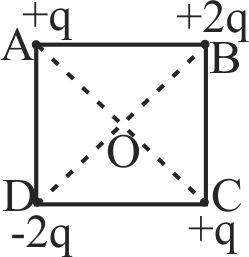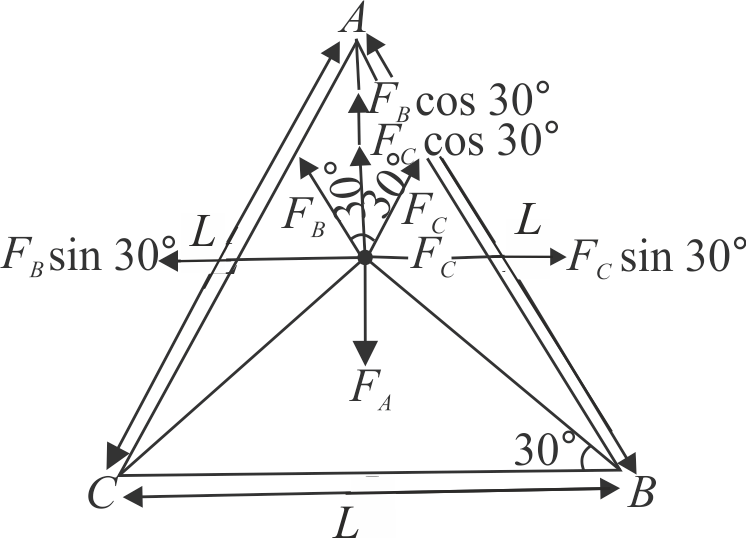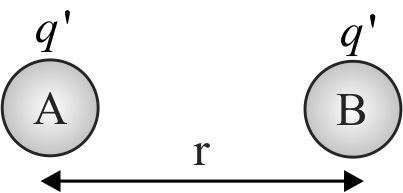358067
Statement A :
The force with which two charges attract or repel each other are not affected by the presence of a third charge.
Statement B :
Force of any charge due to a number of other charges is the vector sum of all the forces on that charge due to other charges.
358068 The force of repulsion between two identical positive charges when kept with a separation \(r\) in air is \(F\). Half the gap between the two charges is filled by a dielectic slab of dielectric constant \( = 4\).Then the new force of repulsion between those two charges becomes
358069 Two identical conducting balls \(A\) and \(B\) have positive charges \({q_1}\) and \({q_2}\) respectively. But \({q_1} \ne {q_2}\).The balls are brought together so that they touch each other and then kept in their original positions. The force between them is
358067
Statement A :
The force with which two charges attract or repel each other are not affected by the presence of a third charge.
Statement B :
Force of any charge due to a number of other charges is the vector sum of all the forces on that charge due to other charges.
358068 The force of repulsion between two identical positive charges when kept with a separation \(r\) in air is \(F\). Half the gap between the two charges is filled by a dielectic slab of dielectric constant \( = 4\).Then the new force of repulsion between those two charges becomes
358069 Two identical conducting balls \(A\) and \(B\) have positive charges \({q_1}\) and \({q_2}\) respectively. But \({q_1} \ne {q_2}\).The balls are brought together so that they touch each other and then kept in their original positions. The force between them is
358067
Statement A :
The force with which two charges attract or repel each other are not affected by the presence of a third charge.
Statement B :
Force of any charge due to a number of other charges is the vector sum of all the forces on that charge due to other charges.
358068 The force of repulsion between two identical positive charges when kept with a separation \(r\) in air is \(F\). Half the gap between the two charges is filled by a dielectic slab of dielectric constant \( = 4\).Then the new force of repulsion between those two charges becomes
358069 Two identical conducting balls \(A\) and \(B\) have positive charges \({q_1}\) and \({q_2}\) respectively. But \({q_1} \ne {q_2}\).The balls are brought together so that they touch each other and then kept in their original positions. The force between them is
358067
Statement A :
The force with which two charges attract or repel each other are not affected by the presence of a third charge.
Statement B :
Force of any charge due to a number of other charges is the vector sum of all the forces on that charge due to other charges.
358068 The force of repulsion between two identical positive charges when kept with a separation \(r\) in air is \(F\). Half the gap between the two charges is filled by a dielectic slab of dielectric constant \( = 4\).Then the new force of repulsion between those two charges becomes
358069 Two identical conducting balls \(A\) and \(B\) have positive charges \({q_1}\) and \({q_2}\) respectively. But \({q_1} \ne {q_2}\).The balls are brought together so that they touch each other and then kept in their original positions. The force between them is
358067
Statement A :
The force with which two charges attract or repel each other are not affected by the presence of a third charge.
Statement B :
Force of any charge due to a number of other charges is the vector sum of all the forces on that charge due to other charges.
358068 The force of repulsion between two identical positive charges when kept with a separation \(r\) in air is \(F\). Half the gap between the two charges is filled by a dielectic slab of dielectric constant \( = 4\).Then the new force of repulsion between those two charges becomes
358069 Two identical conducting balls \(A\) and \(B\) have positive charges \({q_1}\) and \({q_2}\) respectively. But \({q_1} \ne {q_2}\).The balls are brought together so that they touch each other and then kept in their original positions. The force between them is




